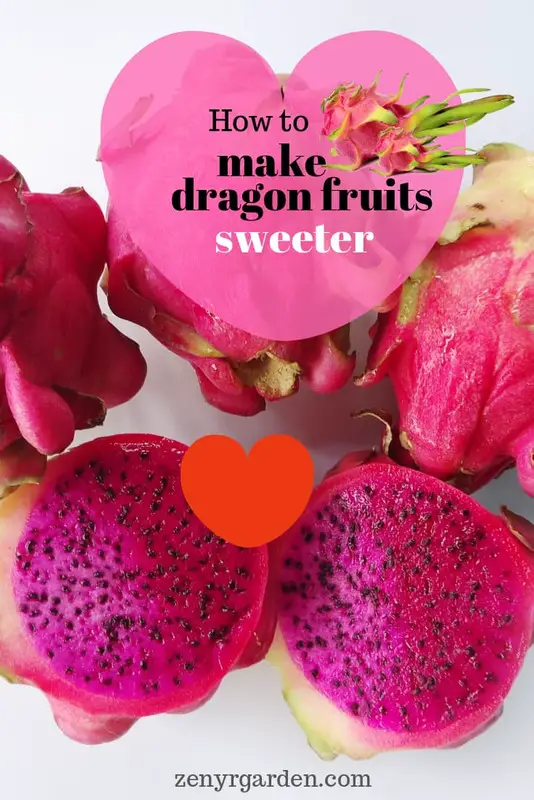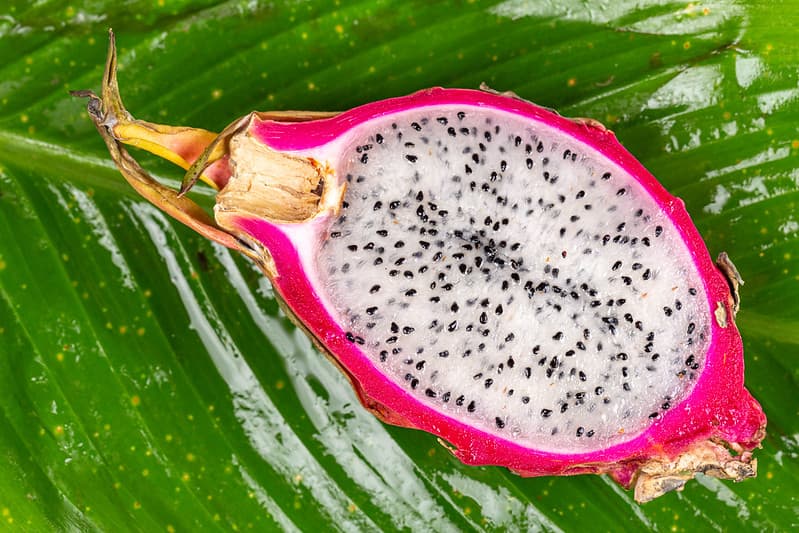Let's find out how to grow sweet-tasting dragon fruits:
Firstly, Not Too Much Sand
Sand is a well-draining material with very low Cation Exchange Capacity (CEC). It doesn't hold well onto the small nutrient particles. So, although it lets water through easily, a flush of water might also flush out the good food we feed the plants, thus making it less sweet.
You can use sand, perlite or rocks as the bottom layer for drainage but not too much of it. This can help some good bits retain for months of feeding, giving your dragon fruits more flavor. Some folks use some small amount of azomite, a type of clay, to help retain the nutrients.
And also, for sweeter dragon fruits remember some:
Good Sunlight
Growers have found that dragon fruits harvested after summer (or in the fall) is often the sweetest of the season. Because those plants get to enjoy some good summer sunlight to nourish their flowers & fruits. Late season fruits, or those that bloom later when the weather cools down, are less sweet.
Around 6 hrs of sunlight is usually a good amount for the dragon fruit vines. But not too much sun either because it might cause sunburn or chlorosis. Dragon fruits are semi-tropical plants. They do like sunlight but not so much as the tropical ones.
Usually, when leaves of plants turn yellow, there may be less chlorophyll (the green pigment) inside. And with less chlorophyll means there'll be less photosynthesis & thus less sugar made. This usually happens when there's extreme heat. And the yellowing is like the plant putting its hands up in the sky to block out the sunlight or a way for it to lessen the amount of sunlight taken in.
It is similar with dragon fruit branches and when you notice them showing signs of yellowing. It may be a cause for less sunlight received and thus less sugars made, hence not-as-sweet fruits. To help dragon fruits with extreme heat (a cause of yellowing) or cold, people graft them on strong rootstocks like Maria Rosa, Vietnam White or Physical Graffiti.
For more grafting tips, you can check out the guide here:
If you use some plant sunscreen or some shade cloth to cover your plants in the summer, it may affect the fruit and sugar production. Some shade cloths reflected out 75% of the sun. So, it slows things down. Play around with certain shade settings to see what fits best for your dragon fruits in the local environment.
Also, for sweet-tasting fruits, check the:
Water
Dragon fruits like moisture but not soggy feet. When completely soaked in water, they can withstand for up to 6-10 days. After that point, it might be very difficult to save them. So, make sure to water your plants a bit moist around the base & not directly on the stems too much.
If you use hay as mulch on the top surface to retain moisture, then you can water 1 day & not water it for 2 days. This means about 3 times/week. If there is no mulch (which acts as a moisture retainer), then you may water them daily.
This varies depending on your soil condition, the local climate. Check them before adding water. It's good to rainbow-sprinkle your plants (you know that rainbow-like stream of water when light shines through), and not a strong downpour of water all around, which may hurt or flush the nutrients all away.
Watering moderately like this can help make sweeter fruits. Also, don't water or overwater 1-2 weeks before the fruits are reaching their peak point. This minimizes cracking & can help with increasing the sugar content.
Staying on the Vines
Sometimes, growers leave the fruits on the vines for too long. The taste then might be quite bland or quite weird. In the video example below you, a variety named Tricia was left on the vine for 3 months.
When harvested and eaten, to some folks, it has a taste like beet. Its sugar content is a low 6.8% Brix (You can check out how to measure the dragon fruit sweetness in this post if you'd like: How to test dragon fruit sweetness).
From our personal experience with another red variety, it does have a hint of beet to it if left to ripen for quite a while.
>> Link YouTube Video:
Dragon Fruit Tasting: Tricia (pollinated by Lisa) & Lisa (pollinated by Tricia) part 2./deep-red-dragon-fruit.jpg)
Some varieties won't be able to stay on the vines for that long. The Purple/Pink variety fruits (Hylocereus polyrhizus) can stay on the vines for about a month. Some other red-fleshed dragon fruits are good on vines for about 10 days. Cho Gao Yellow is one that can be left on the branch for maximum growth with good sugar level.
So, the point is picking it at the right time can help the fruits taste better & sweeter. Some folks like the tartness taste so they pick them early, when there's not already a lot of sugar in the fruit yet. The other risk of leaving fruits for too long on the branches is fungi or other animals eating and enjoying them instead of us the humans.
If possible, choose some sweet and flavorful varieties from the start:
Sweet Varieties
Some of the sweetest varieties are:
- Ecuador Palora
- Sugar Dragon S8
- American Beauty
These are naturally sweet/sweeter varieties so they may get you off to a good start. Check out this post for the taste of different varieties:
And finally, pollination factors may help with our sweet dragons:
Pollination Factors
The pollen quality can affect the fruit sweetness. Too much rain or excess water might affect the pollen quality. This then affects the fruit quality. One way to try is to hand pollinate your dragon fruits.
If you're doing hand pollinating, make sure you get fresh pollen as soon as the flowers open. But do let the pollen mature a bit in the flower so they can be viable. For example, collecting pollen just hours after the flower opening may not be the best for fertility / viability. After collecting the pollen, store them in the fridge for good viability. It's good to use them within 5 days after collecting.
To pollinate American Beauty, for example, you can mix Sugar Dragon + Lisa pollen. Sugar Dragon is well-known for producing strong and viable pollen. So, this may help with the fruit quality and overall sweetness.
We talk about more hand pollination in this post if you'd like a look later:
And finally, you can keep in mind:
For Sweeter-Tasting Fruits
- Make sure the soil is well-draining but can also retain nutrients
- Water lightly because dragon fruits like some moisture, but not too wet
- Don't water or overwater 10-15 days before picking the fruits
- Get the fruits that are in season
- Pick the fruits at the right balanced time
- Choose sweet varieties from the start
- Use fresh pollen from strong species
Bonus tip: Some folks wrap a bag around the fruit after it has ripened for 1 or 2 days. From their experience, this helps with the taste. It is also a good protection against some birds, bats or pests that could consume the fruits before us.
/wrapping-dragon-fruits-with-paper-bags.jpg)
Enjoy your yummy dragon fruits & See you again next time!
Share or pin this post!


